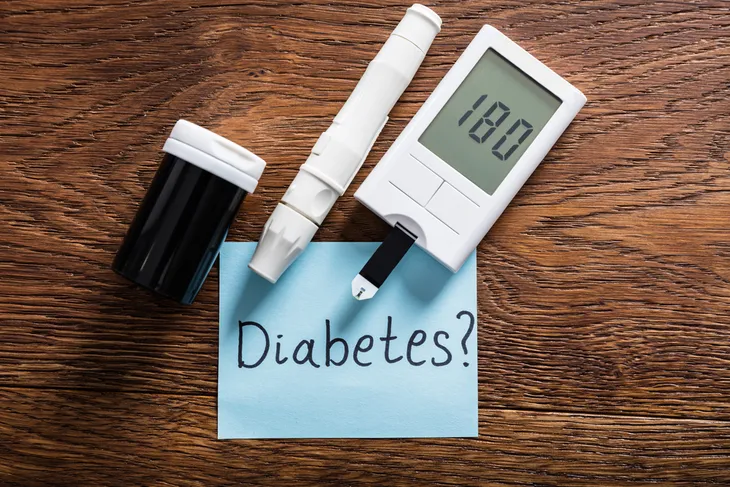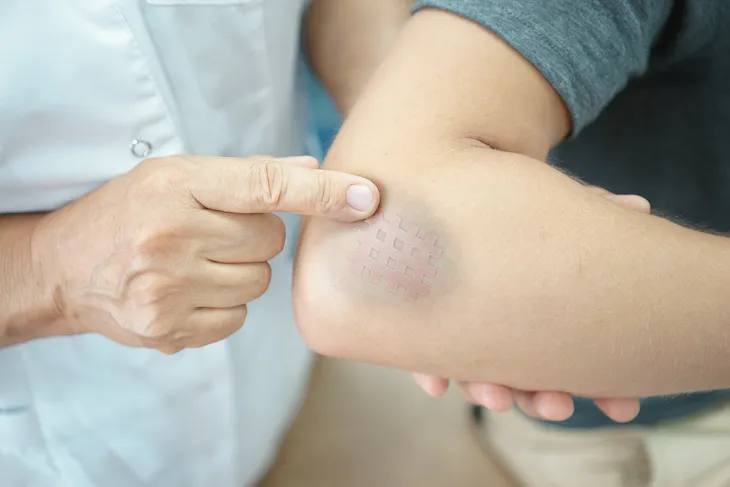While borderline diabetes is less commonly talked about, it’s basically the same thing as diabetes, just a step behind. According to Best Health, there are roughly 84 million Americans who have borderline diabetes, also known as prediabetes. This amounts to roughly 1 in 3 Americans.
Borderline diabetes is the condition leading up to type 2 diabetes. The pancreas is still producing enough of the hormone to respond to ingested carbohydrates, says Healthline, but it’s less effective at removing the sugar from the bloodstream. As a result, blood sugar levels remain high. It doesn’t mean the patient will for sure develop diabetes, but it’s a warning sign of what may come. While it’s scary to be diagnosed with borderline diabetes, it can also be a great wake-up call and provide an opportunity to change course. Here’s a look at 12 of the telltale signs and symptoms of borderline diabetes…
Want diabetes content delivered straight to your inbox? Sign up for our Diabetes newsletter and receive exclusive news and articles written from our team of diabetes experts.
No Symptoms
We’re going to get this one out of the way first. It can be scary to hear that a condition as serious as borderline diabetes doesn’t present any symptoms, but unfortunately it’s true. Possibly one of the reasons why many people don’t catch diabetes in the early “prediabetes” stage is because they have no idea what is going on internally. When they do, it’s too late, and they’ve already developed type 2 diabetes. According to Healthline, “only 10-percent of people with prediabetes even know they have it because many don’t display any symptoms.”
Unintentional Weight Loss
Most of us wouldn’t mind losing a few pounds here and there, but in reality, any sort of drastic weight loss that is unintentional is a red flag. Even though we tend to associate diabetes with obesity and being overweight, blood sugar problems can also cause people to unintentionally lose weight, says Best Health. The Mayo Clinic points out that this could be happening if someone is going to the bathroom to urinate more frequently, which is a common sign and prediabetes, as well as full-blown diabetes. During all this frequent urination, they may be shedding more calories and sugar in the urine.
“Diabetes also keeps sugar from reaching our body’s cells, which leaves us feeling hungry all the time,” says Deena Adimoolam, MD, Assistant Professor of Medicine, Endocrinology, Diabetes, and Bone Disease, Icahn School of Medicine at Mount Sinai. Any person that is eating regularly (and healthy) but is also losing weight drastically should seek medical attention right away.
Dark Spots on Your Skin
It might seem like a strange thing to do, but we should all be paying close attention to our skin to note if there are any changes. This is particularly important not only for skin cancer, but because prediabetes can cause dark patches on the skin called acanthosis nigricans (AN). The American Academy of Dermatology warns that these dark patches could be an early warning sign of prediabetes. “The condition usually appears in elbows, armpits, knees, or on the neck, has a velvety texture, and likely occurs because excess insulin causes a rapid growth of cells,” writes Best Health. “It’s also more common in people with obesity — another risk factor for prediabetes.”
The source cites a study that was conducted by the University of New Mexico which found that patients with AN were more likely to have multiple risk factors for diabetes and that the condition itself was a major risk factor for diabetes. For these reasons, anyone who is diagnosed with AN should also be checked for prediabetes.
You’re Exhausted
We all feel tired from time to time, some days more than others. This is normal and usually due to a lack of sleep or a bad night’s sleep. Someone who is borderline diabetic will find that they are constantly exhausted. “Patients may feel more tired or sluggish,” explains University of Pittsburgh Medical Center (UPMC) endocrinologist Jason Ng, MD, Clinical Assistant Professor of Medicine at the University of Pittsburgh, to Best Health.
The reason they feel so fatigued is because their blood sugar is going up and down. Other factors that can create that sluggish feeling are depression or obesity ,which are also culprits of blood sugar problems, according to a study by researchers at the University of Illinois.
To help increase energy levels, the American Diabetes Association recommends using exercise or any kind of physical activity. While it might seem strange to combat tiredness with something that requires energy, it can help. If your fatigue is so bad that you cannot exercise, go see a doctor.
You Don’t Get Much Sleep
People who have borderline diabetes often have a hard time sleeping. This contributes to their condition, making it worse. “When you don’t get enough sleep, less [hormone that regulates glucose in the blood] is released in the body,” says sleep expert Richard Shane, PhD, creator of the Sleep Easily method, to Best Health. “Sleep deprivation can cause insulin-producing cells to fail to use the insulin efficiently or to stop functioning. Your body also secretes more stress hormones, which interfere with [hormone that regulates glucose in the blood] ability to be effective,” adds the source.
Best Health cites a study from 2013 which found a correlation between the amount of sleep a person gets and prediabetes. The source also notes that the amount of sleep we get also affects our diet because we tend to crave more calories and junk food when we’re tired. We also don’t feel like exercising, which leads to inactivity and weight gain — risk factors linked to prediabetes.
You Suffer From Blurred Vision
Do you find yourself squinting or rubbing your eyes due to blurry vision? Before moving into a full blown panic that you have diabetes, just know there are many other reasons behind poor vision. But borderline diabetes is one of many possible reasons. Deena Adimoolam, MD, told Best Health that eye disease is more likely to occur when a person is suffering from high blood sugar. This is because the high blood sugar causes “damage to the blood vessels in the eye, which can leak and swell, leading to vision changes,” according to Best Health.
There’s even a known condition involving eye damage that is linked with diabetes, which is called diabetic retinopathy. The National Eye Institute notes that this condition is the leading cause of vision loss among diabetics and overall blindness in adults. Best Health cites a study performed by the Diabetes Prevention Program (DPP) which found that nearly 8-percent of prediabetic patients were diagnosed with diabetic retinopathy. Luckily, the condition can be treated if it is found early enough, so any form of blurry vision should be reported to a doctor and be checked out. This is especially true if it’s experienced in tandem with any other symptoms on this list.
You’re Really Thirsty
Being thirsty all the time is a key sign of prediabetes (borderline diabetes). This is due to the body’s inability to process blood sugars. “Prediabetes is caused when the body is unable to efficiently process blood sugars,” says Jason Ng, MD to Best Health. “This happens over time as the body builds up a resistance to [hormone that regulates glucose in the blood], a hormone that helps the body control blood sugars,” adds Dr. Ng.
When someone is resistant to the hormone that regulates glucose in the blood, their body just begins producing more and more of the hormone in order to keep their blood sugar at a normal level. Best Health explains that the body will eventually not be able to keep up, so blood sugar levels rise.
As we previously mentioned, a person with borderline diabetes is urinating more which is another reason why they need more water and seem perpetually thirsty. According to Bustle, this could be a sign of prediabetes.
Frequent Urination
This one might seem rather annoying at first, but it’s a telltale sign of prediabetes. Someone who is developing or has developed borderline diabetes will begin to urinate on a very frequent basis. This is likely linked to the fact that they are also experiencing increased thirst. “A patient may feel slightly more thirsty and have to urinate more over time as well as the sugars increase in their body,” says Dr. Ng when talking to Best Health.
“Normally glucose would be absorbed by the kidneys through the blood to make urine, and then returned back to the bloodstream,” explains Leah de Souza-Thomas, BSc, MSc, MPH, to Bustle. “When a person’s blood glucose levels are abnormally, high not all of the glucose can be reabsorbed, and the excess goes into the urine where it’s presence draws in more water from the blood. This leads to unusually high volumes of urine,” adds the source.
You Have Polycystic Ovary Syndrome (PCOS)
PCOS is one of many risk factors for prediabetes/diabetes. This is surprising because to us and researchers, there seems to be no known link between the two. In fact, the American Diabetes Association reports the link between these two conditions is still unclear, but the main connection is likely [hormone that regulates glucose in the blood]. High levels of this hormone “may contribute to the increased production of male hormones called androgens, which is a symptom of PCOS,” writes Best Health. “PCOS is also associated with being overweight, as is prediabetes — but studies have shown that even normal-weight women with PCOS are at increased risk of high blood sugar,” adds the source.
Another possible correlation between the two is that women with PCOS are more likely to have gestational diabetes, which can also increase a woman’s risk of developing type 2 diabetes. Any woman that is diagnosed with PCOS should also have their blood sugar levels checked by a doctor to make sure they are not at risk for prediabetes.
High Cholesterol
In addition to high blood sugar levels, prediabetes can cause high cholesterol. Unfortunately, this symptom isn’t something that can really be spotted on its own. It’s something that only a doctor will notice and usually only through blood tests.
The hormone produced by the pancreas to regulate glucose in the blood also “stimulates your liver to increase production of cholesterol,” says Ron Ledoux DC, CCN, to Bustle in an interview over email. “Elevated cholesterol, increased triglycerides, and a triglyceride to HDL [high-density lipoprotein or “bad cholesterol”] ratio greater than 3 is an indicator that your blood sugar levels are rising,” adds the source.
Slow Wound Healing
We all get cuts and bruises every now and again from the wear and tear of everyday life, and while they might sting a little, depending on how bad they are, they’ll likely be gone in a few days. But, what if they never healed or took longer than normal to heal? Anyone who notices that their cuts and bruises are healing slower should be checked for prediabetes.
“The immune system and circulation play vital roles in wound healing,” says Dr. James Hanna during an email interview with Bustle. “If pre-diabetes or type 2 diabetes has negatively impacted immune function or circulation, then injuries such as cuts and bruises may be slow to heal,” adds the source.
You Have a Family History of Diabetes
Anyone who has a known family history of diabetes is at a higher risk for developing diabetes than someone who doesn’t have a family history of the disease. “There can be a genetic cause for the development of type 2 diabetes due to certain gene mutations,” says Deena Adimoolam, MD, to Best Health. “Some people may have a genetic predisposition to developing type 2 diabetes due to presence of certain genes than have been passed down from one generation to the next,” adds Dr. Adimoolam
The source cites a European study which found that having a family history of diabetes can increase a person’s chance of developing diabetes by 26-percent. In fact, according to the National Institute of Diabetes and Digestive and Kidney Diseases (NIDDK), most people who have diabetes will have a close family member who has the condition as well. “Some data suggests that the risk of type 2 diabetes is five times higher in those with diabetes on both the maternal and paternal sides of the family,” says Dr. Adimoolam to Best Health.















